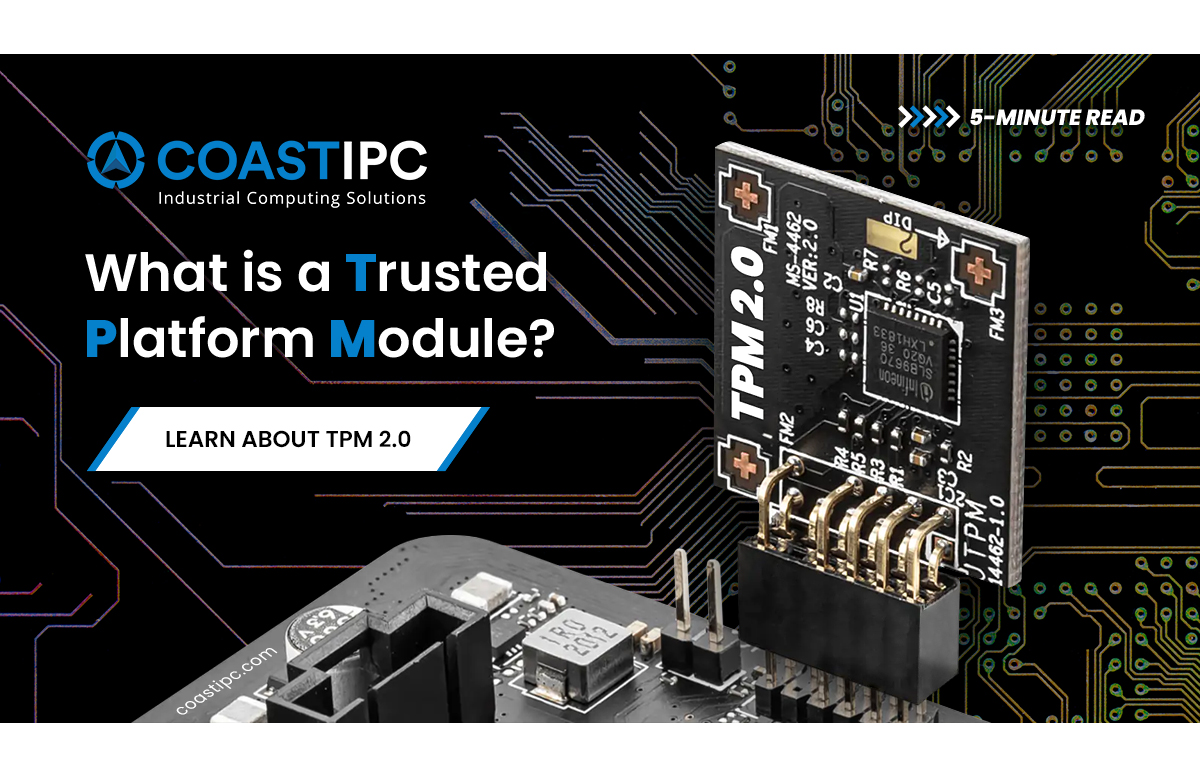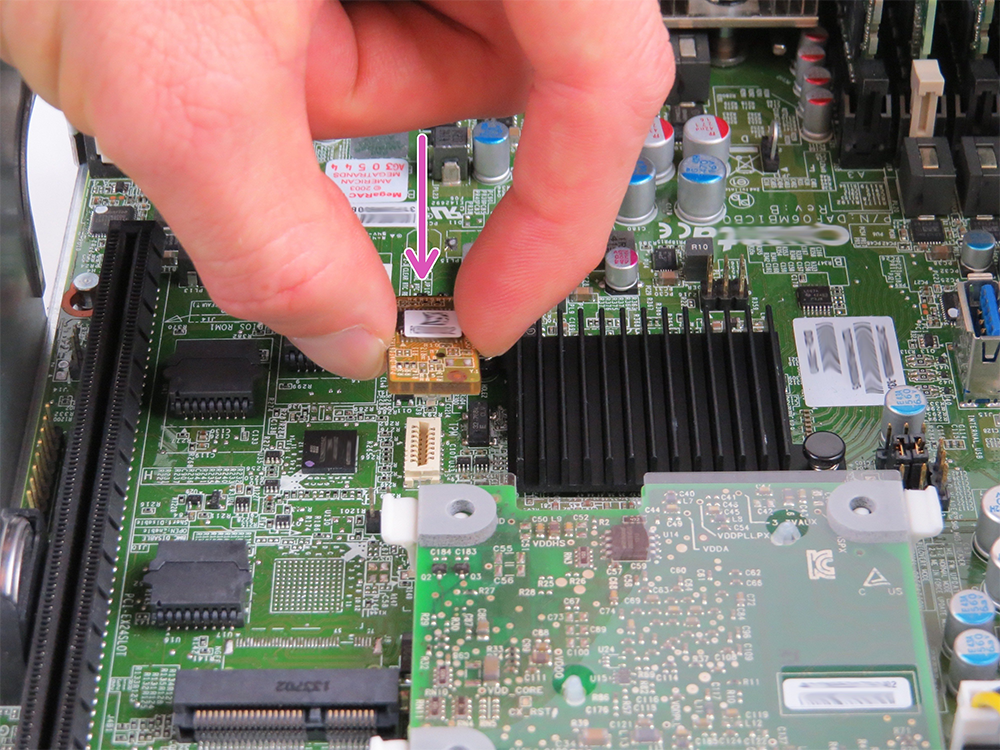
The Internet of Things (IoT) has grown at an incredible pace, transforming the way businesses operate and collect data. By 2025, it’s estimated that over 73 billion IoT devices will be in use. Many of these will be deployed at the network edge, where high-performance computers gather, process, and act on data in real-time. While this enables faster decision-making and more efficient operations, it also introduces a new level of cybersecurity risk.
Every connected device in an IoT system is a potential target for cyberattacks. Hackers can exploit these endpoints to steal sensitive data, install malware, or control critical systems. Often placed in remote or unmonitored environments, Edge computers are particularly vulnerable to physical and network-based threats. The stakes are high, but one technology is stepping up to provide a much-needed layer of defense: Trusted Platform Modules (TPMs).

What is a TPM?
A Trusted Platform Module (TPM) is a specialized security chip embedded into a device’s motherboard during manufacture or added via a module. It serves as the "root of trust" for a device, employing hardware-based protocols for storing sensitive information like encryption keys, passwords, and user credentials. These keys are essential for ensuring the integrity of the device’s boot process, safeguarding sensitive data, and verifying the authenticity of hardware and software components. A TPM acts as a secure key vault that enhances your overall computer security.
Initially developed in the late 1990s, TPMs were designed to address the vulnerabilities of early internet-connected devices. The first standardized version, TPM 1.2, introduced foundational security features such as unique device identifiers, encryption capabilities, and secure boot processes. These tools helped protect systems from various threats, but as cyberattacks became more sophisticated, so did the need for enhanced security. Enter TPM 2.0.
What is a Discrete TPM (dTPM)?
A discrete TPM (dTPM) is a standalone chip that operates independently of the device’s central processor. It provides unmatched security by isolating cryptographic operations in dedicated hardware. This isolation makes dTPMs highly resistant to physical tampering and cyberattacks. They are ideal for high-security environments, such as industrial control systems and financial services, where robust protection is critical.
By maintaining independent operation, dTPMs ensure that every stage of a device’s lifecycle, from boot-up to runtime, can be trusted and authenticated, thwarting unauthorized alterations. This hardware-based approach offers optimal protection through physical tamper resistance, secure key storage, and isolated execution environments. These features make it significantly more resilient to advanced and sophisticated attacks than systems relying solely on software-based solutions.
What Makes TPM 2.0 Better?
TPM 2.0 is an upgrade built for today’s cybersecurity challenges. Unlike its predecessor, which was limited to a single cryptographic algorithm (SHA-1), TPM 2.0 supports multiple algorithms. It can adapt to evolving threats by switching to more secure options. It also introduces new features like biometric authentication, GPS integration, and flexible key management, making it easier to tailor security measures to the specific needs of different devices and deployments.
This flexibility is especially valuable in IoT, where devices range from powerful industrial PCs to resource-constrained sensors. With TPM 2.0, manufacturers can include only the features a device needs, ensuring strong security without overburdening the system.

Does Your Computer Have a TPM 2.0 Chip? (Source: https://redmondmag.com/)
Types of TPMs: A Comparative Overview
TPMs come in several types, each suited to different applications and security requirements. Here’s a closer look at the primary types of TPMs and their key characteristics:
1. Discrete TPM (dTMP)
Discrete TPMs are standalone chips integrated into a device’s motherboard. These TPMs are considered the gold standard in terms of security because they are physically isolated from the device’s main processing unit, making them highly resistant to tampering. They are ideal for applications requiring the highest level of protection, such as industrial control systems or financial services.
Advantages: Superior security, independent operation, hardware-based protection.
Disadvantages: Higher cost, larger physical footprint.
2. Integrated TPM (iTMP)
Integrated TPMs are built into the main processor as part of the device’s architecture. They share some of the advantages of discrete TPMs but may not be as isolated, which could slightly reduce security in some scenarios. They are a good balance of security and cost for many IoT applications.
Advantages: Compact design, reduced manufacturing costs, sufficient security for most use cases.
Disadvantages: Less isolated than discrete TPMs, potentially lower resistance to sophisticated physical attacks.
3. Firmware TPM (fTPM)
Firmware TPMs implement TPM functionality within the system firmware. These are commonly used in consumer-grade devices like laptops and smartphones. While they provide strong protection against most software-based attacks, their lack of dedicated hardware makes them less robust against physical tampering.
Advantages: Cost-effective, easily upgradable, small footprint.
Disadvantages: Dependent on the main processor, less resistant to physical attacks.
4. Software TPM (sTPM)
Software TPMs emulate TPM functionality entirely through software. While they offer flexibility and ease of deployment, they are generally the least secure option because they lack any hardware-based protection. They are best suited for environments where physical security is assured and cost is a primary concern.
Advantages: Flexible, low-cost, easy to implement.
Disadvantages: Susceptible to both physical and software-based attacks, lower overall security.
5. Virtual TPM (vTPM)
Virtual TPMs operate within a virtualized environment, providing TPM functionality to virtual machines. These are commonly used in cloud computing and other virtualized infrastructures where multiple VMs need independent security.
Advantages: Scalable, suitable for cloud-based environments, provides TPM functionality in virtual contexts.
Disadvantages: Dependent on the hypervisor, potential vulnerabilities in virtualization layers.

Why TPMs Are Essential for IoT Security
TPMs serve as a crucial line of defense for IoT devices, especially those deployed at the edge. By creating secure certificates and encrypting data transmissions, TPMs ensure that connected devices can communicate safely and that sensitive information stays protected.
This kind of security is non-negotiable in industrial IoT (IIoT) environments. Imagine a factory where edge computers control machinery or monitor processes. A single compromised device could disrupt production, damage equipment, or even put workers at risk. With TPM-enabled security, businesses can prevent unauthorized code from interfering with their operations and ensure systems function as intended.
TPMs also play a key role in meeting data privacy and security regulatory requirements. Whether it’s GDPR, HIPAA, or PCI-DSS, many regulations require businesses to encrypt sensitive data. TPMs make this possible by providing a secure foundation for encryption, reducing the risk of costly breaches, and protecting consumer trust.
Solutions for Industrial Applications
At CoastIPC, we understand the challenges of protecting IoT systems in demanding environments. That’s why our TPM 2.0-capable industrial PCs, like the MIC-733-AO, Nuvo-9000, and POC-700 Series, are designed to deliver cutting-edge performance and industry-leading security. Whether your application involves advanced machine vision systems or mission-critical industrial automation, our devices ensure that your operations are efficient and secure.
By offering the option of integrating TPM 2.0 technology directly into the hardware, our systems provide peace of mind that your data, devices, and workflows are protected from ever-evolving threats. In industrial environments, where downtime can be costly and vulnerabilities aren’t an option, we deliver solutions you can trust.

TPM Replacement (Source: https://opencompute.dozuki.com/)
Securing the Future of IoT
The rapid growth of IoT is transforming industries, offering unprecedented opportunities to optimize processes, improve outcomes, and drive innovation. However, this evolution also brings new challenges, especially regarding safeguarding devices and data. To thrive in this connected era, businesses need powerful and secure tools.
TPM technology is a cornerstone of modern IoT security, and with CoastIPC’s TPM 2.0-capable systems, you’re prepared for the future. From machine vision applications to industrial automation, our solutions help you achieve your goals without compromising security. After all, innovation without protection isn’t progress—it’s just a risk waiting to happen.

